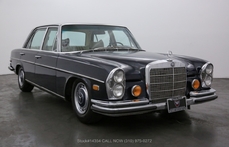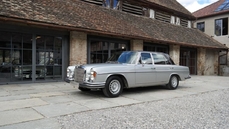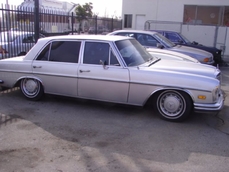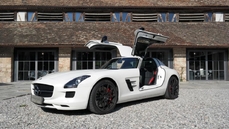Mercedes-Benz 300SEL 6.3 w109 SEL 6.3 1970
General description :
Dieser wunderschöne 300 SEL 6.3 wurde im Juni 1970 in Deutschland ausgeliefert. Der Wagen (übrigens damals die schnellste Serienlimousine Europas) hatte dann im Anschluss noch 2 weitere deutsche Besitzer bevor er mit extremen Aufwand von einem deutschen Sammler zur Rallyeversion "Rote Sau" umgebaut wurde. Der Umbau wurde ohne jegliche Kosten und Mühen zu scheuen von der Firma Kienle Automobiltechnik vorgenommen. Es liegen zahlreiche Rechnungen der Restauration und dem Umbau dieses Fahrzeugs vor. Der Wagen befindet sich nach dem ausgesprochenen authentischen und gelungenen Umbau auf Neuwagen-Niveau. Jedes selbst noch so kleine Detail wurde vom original Fahrzeug übernommen. So wurde neben der Optik auch die Technik größtenteils dem original angepasst. Der Innenraum wurde abgeändert, Fahrwerk und Felgen geändert sowie Auspuffanlage, Motor sowie Luftansaugung optimiert. Die "Rote Sau" war übrigens der erste von AMG vom Serienstand zum Rennwagen verwandelte Fahrzeug und ist bis heute eine Motorsport-Ikone!
Wir bieten dieses Fahrzeug in perfektem Zustand mit neuem TÜV sowie der begehrten H-Zulassung an. Alle Umbauten sind vom TÜV abgenommen. Sichern Sie sich dieses Stück Automobile Rennsportgeschichte!
This beautiful 300 SEL 6.3 was delivered in June 1970 in Germany. The car (incidentally then the fastest Serienliousine Europe's) then had two more German Besizer before he was rebuilt with extreme effort by a German collector to the rally version "Red sow". The conversion was made without any cost and effort to shy away from the company Kienle Automotive. There are numerous bills of the restoration and the conversion of this vehicle before. The car is after the pronounced authentic and successful conversion to new car level. Every detail, even the smallest, was taken over by the original vehicle. Thus, in addition to the appearance of the vehicle, the technology was largely adapted to the original. The interior has been modified, chassis and rims changed and optimized exhaust system, engine and air intake. Incidentally, the "red sow" was the first vehicle that AMG has converted from series status to a racing car and is still a motorsport icon to this day!
We offer this vehicle in perfect condition with new TÜV and the coveted H-approval. All conversions have been approved by TÜV. Get this piece of automotive racing history!
Zwischenverkauf und Irrtümer für dieses Angebot sind ausdrücklich vorbehalten. Ausschlaggebend sind einzig und allein die Vereinbarungen im Kaufvertrag.
https://www.hk-engineering.de/de/fahrzeuge/sonstige_fahrzeuge/?angebot=278
1970 Mercedes-Benz 300SEL 6.3 w109 SEL 6.3 is listed sold on ClassicDigest in Polling by Auto Dealer for €119000.
Car Facts
Car type : Car Make : Mercedes-Benz Model : 300SEL 6.3 w109 Model Version : SEL 6.3 Engine size : 0.0 Model Year : 1970 Location : Polling
Sold
Seller Information
Sold
People who viewed this Mercedes-Benz 300SEL 6.3 w109 also viewed similar Mercedes-Benz listed at ClassicDigest
Other cars listed for sale by this dealer
About Mercedes-Benz
In the annals of automotive history, the journey of Mercedes-Benz is a tale that unfolds with the ingenuity of its founding pioneers. In the year 1886, Karl Benz crafted the Benz Patent Motorwagen, a creation that would go down in history as the world's inaugural automobile. Unbeknownst to him, this moment marked the genesis of what would evolve into the most illustrious premium car manufacturer globally. The financial underpinning of this pioneering venture, interestingly, was provided by Karl Benz's wife, Bertha Benz, demonstrating a remarkable partnership that would set the tone for Mercedes-Benz's legacy.A parallel narrative emerged not far away, as Daimler-Motoren-Gesellschaft, founded by Gottlieb Daimler and Wilhelm Maybach, entered the scene. In 1901, they unveiled their automobile under the now-famous moniker "Mercedes," meaning "godsend" in Spanish. This name was bestowed upon the car at the behest of Emil Jellinek's daughter, the distributor for Daimler-Motoren-Gesellschaft. The wheels of innovation were set in motion.
Fast forward to 1926, a pivotal year that witnessed the merger of Daimler with Benz & Cie., culminating in the birth of Daimler-Benz. The amalgamation saw the adoption of "Mercedes-Benz" as the distinguished trademark for their automobiles, fusing the legacies of two visionary entities into one.
Contrary to perceptions of conservatism, the trajectory of Daimler-Benz unfolds as a chronicle of industry firsts. From the introduction of the honeycomb radiator to the float carburetor, and the pioneering implementation of four-wheel brakes in 1924, Daimler-Benz consistently pushed the boundaries of automotive innovation. The diesel-powered Mercedes-Benz 260 D in 1936 marked the inception of diesel engines in passenger cars. The iconic Mercedes-Benz 300SL Gullwing made history as the first car with direct fuel injection, albeit the Gutbrod's tiny 2-stroke engine can claim precedence.
Safety innovations became a hallmark, with Béla Barényi's patented safety cell design in the "Ponton"-models in 1951, featuring front and rear crumple zones. The W116 450SEL 6.9 saw the introduction of the Anti-Lock Brake system (ABS), another pioneering safety feature. From the first production airbags and beyond, the legacy of "firsts" continued to be etched into the fabric of Daimler-Benz.
Over its centennial journey, Mercedes-Benz has not merely produced cars but has sculpted automotive icons. The SSKL, 710 SSK Trossi Roadster, 770K Grosser, 540K Spezial Roadster, 300SL Gullwing, w100 600 Pullman, w111 280SE 3.5 Flachkühler, w113 230SL Pagoda, w109 300 SEL 6.3, and w201 2.3-16 Cosworth stand testament to the brand's commitment to engineering excellence.
The roaring Silver Arrows, or "Silberpfeile," including the W 25, W 125, W154, W165, and W196, created a legacy of dominance on the racetrack. These machines were not merely cars; they were expressions of precision, speed, and an indomitable spirit that left their competitors in the dust.
As Mercedes-Benz marches into the future, it does so not just as an automaker but as a custodian of a legacy, a torchbearer of innovation, and a beacon of automotive excellence. The road ahead is sure to witness the continued fusion of cutting-edge technology, timeless design, and an unwavering commitment to setting new standards in the world of automobiles.
One luminary figure who left an indelible mark was Béla Barényi, often heralded as the "father of passive safety" for his pioneering work in safety engineering. His patented safety cell design, featuring front and rear crumple zones, became a hallmark of Mercedes-Benz's commitment to occupant safety, setting new standards that reverberated throughout the automotive world.
Moving through the chronicles, the collaborative genius of Wilhelm Maybach, alongside Gottlieb Daimler, laid the foundation for Daimler-Motoren-Gesellschaft. Their innovations not only birthed the first Mercedes but established a culture of relentless pursuit of technological excellence that remains integral to Mercedes-Benz's DNA.
In the post-merger era of 1926, Ferdinand Porsche emerged as a prominent figure within Mercedes-Benz. His work on the Mercedes-Benz S-Type, a supercharged race car, garnered acclaim and set the stage for a legacy that extended far beyond the marque. Porsche's impact would later extend to his eponymous company, but his influence at Mercedes-Benz during those formative years was pivotal.
As the 20th century progressed, the legendary Rudolf Uhlenhaut emerged as a key figure. Uhlenhaut, an accomplished engineer and the driving force behind the iconic Silver Arrows, played a crucial role in Mercedes-Benz's dominance in motorsports. His engineering prowess and attention to detail were instrumental in creating some of the most formidable racing cars of the era.
In the latter half of the century, figures like Bruno Sacco, the head of design at Mercedes-Benz from 1975 to 1999, left an indelible imprint on the brand's aesthetic identity. Sacco's design philosophy, characterized by clean lines and timeless elegance, shaped iconic models like the W126 S-Class and the W201 190E, solidifying Mercedes-Benz's reputation for luxury and sophistication.
The narrative would be incomplete without acknowledging the contributions of engineers like Hans Scherenberg, whose leadership in the 1970s ushered in a new era of technological innovation at Mercedes-Benz. Scherenberg's tenure saw the development of groundbreaking technologies, including the Anti-Lock Brake system (ABS) and the introduction of airbags in production cars.











